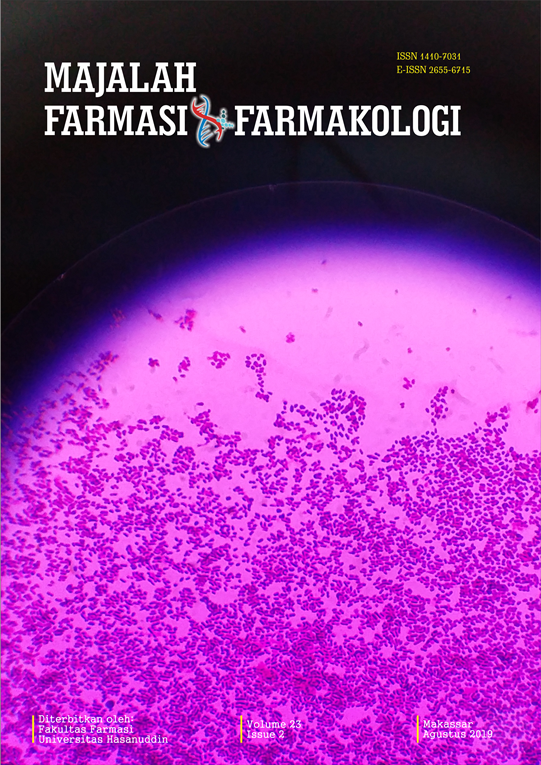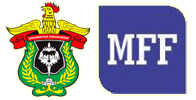SKRINING POTENSI PROBIOTIK DAN SITOTOKSIK BAKTERI Weisella confusa ISOLAT DANGKE SAPI
Abstract
Kasus kanker kolorektal mengalami peningkatan setiap tahunnya di seluruh dunia. Salah satu upaya pencegahan kanker kolorektal ialah melalui konsumsi probiotik. Weisella confusa tergolong dalam kelompok bakteri asam laktat, isolasi bakteri ini dangke merupakan hal yang baru dan aktivitas probiotik dari isolat ini belum diketahui. Penelitian ini bertujuan menguji sifat probiotik W. confusa isolat dangke dan potensi sitotoksiknya terhadap larva udang Artemia salina sebagai skrining awal efek antikanker. Metode pengujian sifat probiotik meliputi uji toleransi terhadap pH rendah dan uji toleransi terhadap garam empedu. Skrining efek sitotoksik dilakukan menggunakan metode BSLT(Brine Shrimp Lethality Test) menggunakan hasil fermentasi 72 jam dari isolat. Berdasarkan hasil pengujian, W. confusa isolat dangke menunjukkan sifat toleran terhadap pH 2 dan garam empedu 0,3%. Hasil uji sitotoksikmenunjukkan bahwa filtrat hasil fermentasi memiliki nilai LC50 lebih dari 1000 µg/ml yang menandakan sampel tidak berefek sitotoksik.Disimpulkan bahwabakteri W.confusa isolat dangke menunjukkan potensi sebagai probiotik namun tidak bersifat sitotoksik sehingga tidak berpotensi untuk dilanjutkan pada uji antiproliferasi terhadap sel kanker. Pengujian aktivitas biologis lainnya disarankan untuk mengetahui potensi lain dari bakteri ini.
References
Pusat Data dan Informasi. 2015. InfoDatin Stop Kanker. Jakarta: Kementrian Kesehatan
Kumar KS, Sastry N, Polaki H, Mishra, V. Colon Cancer Prevention through Probiotics: An Overview. Cancer Sci Ther. 2015;7(2): 81-92. doi:10.4172/1948-5956.1000329
Kahouli I, Tomaro-Duchesneau C, Prakash S. Probiotics in Colorectal Cancer (CRC) with Emphasis on Mechanism of Action and Current Perspectives. J Med Microbiol. 2013; 62:1107-1123. doi: 10.1099/jmm.0.048975-0
O’Bryan CA, Pak D, Crandall PG. Lee SO. Ricke SC. The Role of Prebiotics and Probiotics in Human Health. J. Prob Health. 2013;1(2): 108-116. DOI: 10.4172/2329-8901.1000108
Lee YK, Salminen S, editors. Handbook of Probiotics and Prebiotics. 2nd Edition. New Jersey: John Wiley & Sons, Inc; 2009.
Soccol CR et al. The Potential of Probiotics: A Review. Food Technol. Biotechnol. 2010;48 (4): 413-434. ISSN: 1330-9682.
Djide NJN., Asri RM. Potensi Bakteri Probiotik dari Dangke sebagai Kandidat Penghasil Antikanker Melalui Uji Antiproliferasi Terhadap Sel Kanker Kolorektal WiDr [Laporan Penelitian]. Makassar: Universitas Hasanuddin; 2018.
Rajabi S, Ramazani A, Hamidi M, Naji T. Artemia salina as a Model Organism in Toxicity Assessment of Nanoparticles. DARU Journal of Pharmaceutical Sciences. 2015; 23(20). DOI 10.1186/s40199-015-0105-x
Sujaya IN, et al. Potensi Lactobacillus spp. Isolat Susu Sumbawa sebagai Probiotik. Jurnal Veteriner. 2008;9(1): 33-40.
Fusco V, et al. The Genus Weisella: Taxonomy, Ecology and Biotechnological Potential. Frontiers in Microbiology. 2015; 6:155.
Ljungh Å, Wadström T. Lactobacillus Molecular Biology: From Genomics to Probiotics. United Kingdom: Caister Academic Press. 2009.
Siddiqui R, Alam M, Amin MR, Shahid-Ud-Daula AFM, Hossain MM. Screening of Antimicrobial Potential and Brine Shrimp Lethality Bioassay of The Whole Plant Extract of Sphilantes panicullata Wall. ex DC. Stamford Journal of Microbiology. 2013;3(1): 1-5. ISSN: 2074-5346
Downloads
Published
Issue
Section
License
The copyright to this article is transferred to Universitas Hasanuddin (UNHAS) if and when the article is accepted for publication. The undersigned hereby transfers all rights in and to the paper including without limitation all copyrights to UNHAS. The undersigned hereby represents and warrants that the paper is original and that he/she is the author of the paper, except for material that is clearly identified as to its original source, with permission notices from the copyright owners where required. The undersigned represents that he/she has the power and authority to make and execute this assignment.
We declare that:
- This paper has not been published in the same form elsewhere.
- It will not be submitted anywhere else for publication prior to acceptance/rejection by this Journal.
- A copyright permission is obtained for materials published elsewhere and which require this permission for reproduction.
Furthermore, I/We hereby transfer the unlimited rights of publication of the above-mentioned paper in whole to UNHAS The copyright transfer covers the exclusive right to reproduce and distribute the article, including reprints, translations, photographic reproductions, microform, electronic form (offline, online) or any other reproductions of similar nature.
The corresponding author signs for and accepts responsibility for releasing this material on behalf of any and all co-authors. This agreement is to be signed by at least one of the authors who have obtained the assent of the co-author(s) where applicable. After submission of this agreement signed by the corresponding author, changes of authorship or in the order of the authors listed will not be accepted.


